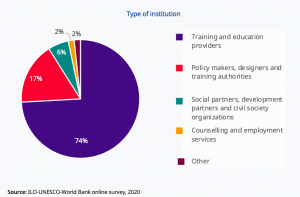Introduction
With the rapid adoption of distance learning models, teachers play a key role in mitigating the impact of the COVID19 crisis on students; legislators must make the most of their abilities now and when schools reopen.
Changing lives by improving education around the world
The most recent international evidence shows that teachers are still at the center of successful distance learning, but they face great challenges. No matter how good the resources, from online platforms to radio broadcasts, the evidence shows that student learning depends on large numbers of teachers and students. However, teachers face considerable challenges when working away from students. We can provide training to help teachers deal with typical challenges that prevent students from learning in six key areas:
Teachers must establish strategies for ongoing communication with students, especially in low-resource settings. 444 Teachers struggle with digital skills. In OECD countries, 35% of 4,444 2 students’ school teachers lack the skills to “integrate digital devices into teaching (McAleavy, T. & Gorgen, K. 2020).
Teachers find it very burdensome to manage online and distance teaching resources, reducing the time spent interacting with students. Teachers need special strategies to establish a strong “virtual presence” with students. Evidence shows that the natural lack of social interaction with students can lead to disconnection and alienation, and the establishment of “teacher presence” is an important part of distance education.
Compared to the traditional setting, teachers have less real-time information on student understanding and progress, making adaptive teaching more challenging. Teachers need support to meet the growing challenges of ensuring and supporting fair outcomes. The home environment will exacerbate disadvantages, and the increased use of online learning also brings its own protection risks.
In addition to the crisis, teachers also need support to deal with the teaching challenges of reopening schools, such as providing compressed courses or remedial plans and possibly handling the transition period in and out of the distance learning environment.
Figure 1.0
7 tips to improve education training during remote teaching
- Conduct analysis – The pre-intervention needs assessment of teachers includes remote teacher self-assessment and 360-degree feedback from line managers, or real-time needs assessment at the beginning of the online course
- Develop a resource-efficient teacher center to support broadcast and virtual learning environments (VLE). Ensure that teachers have access to quality-assured resources selected according to local courses, which can be adapted to work in a resource-poor environment
- Develop engaging interactive content for remote teacher’s CPD. As an interactive activity on WhatsApp and Zoom, online Modules and guided self-study assignments, covering basic topics, including digital skills, protection, student participation strategies (via radio, TV, and online resources), and progress and evaluation.
- Provide continuous remote support to demonstrate good practices and provide real-time Help to clarify and resolve issues and access
- Distribute printed materials
- Mobile SD card or tablet preloaded with resources for teachers, such as
- Videos, recordings, and sample courses for offline access
- Audio and video sharing
- Teacher-specific mobile application, integrated using VLE
- Provide ongoing support for mentoring, mentoring, and practice communities in all settings, including low-tech solutions, including 1: 1 mobile teacher guidance, and virtual communities of practice.
- Establish the broader system needed to support the. Remote Teacher Delivery of Developing Distance Learning Standards and Developing a Quick Guide for Parents and Principals.
- Monitoring Impact and Participation includes Tracking the Use of Distance Learning Materials, Feedback and Satisfaction of Students teachers, and tools to assess teacher skills before and after CPD activities.
Setting up risk management strategies helps safety schools improve their management quality. Safety schools are defined by their culture, management, and psychological guidance. In this regard, schools have emphasized the importance of focusing on strategic planning in order to place school management in a quality perspective. Focusing on risk management is an important concept in quality for school administrators.
References –
Reports used – https://www.ilo.org/wcmsp5/groups/public/—ed_emp/—ifp_skills/documents/publication/wcms_766557.pdf
McAleavy, T. and Gorgen, K. (2020) What does the research suggest is best practice in pedagogy for remote teaching? The EdTech Hub.
Submitted By: Ananya Mangwani, Member of Student Risk Club (SRC)











